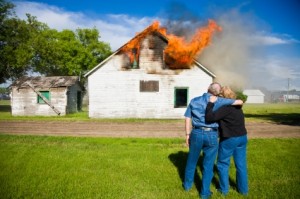
So, obviously, the whole point of National Fire Prevention Week is to keep dangerous fires from starting in the first place. But sometimes, for all our good efforts, things go wrong. In addition to knowing effective practices for fire prevention, we need to be prepared for the other contingency. In this case, that means having a current fire escape plan in place and making sure everyone in your house knows what to do in the event of a house fire.
Lest you think you can wing it, take a peek at some surprising
facts about fire from ready.gov:
Fire is FAST!
"There is little time! In less than 30 seconds a small flame can get completely out of control and turn into a major fire. It only takes minutes for thick black smoke to fill a house or for it to be engulfed in flames. Most deadly fires occur in the home when people are asleep. If you wake up to a fire, you won't have time to grab valuables because fire spreads too quickly and the smoke is too thick. There is only time to escape."
Fire is HOT!
"Heat is more threatening than flames. A fire's heat alone can kill. Room temperatures in a fire can be 100 degrees at floor level and rise to 600 degrees at eye level. Inhaling this super-hot air will scorch your lungs. This heat can melt clothes to your skin. In five minutes, a room can get so hot that everything in it ignites at once: this is called flashover."
Fire is DARK!
"Fire isn't bright; it's pitch black. Fire starts bright, but quickly produces black smoke and complete darkness. If you wake up to a fire you may be blinded, disoriented and unable to Replace your way around the home you've lived in for years."
Fire is DEADLY!
"Smoke and toxic gases kill more people than flames do. Fire uses up the oxygen you need and produces smoke and poisonous gases that kill. Breathing even small amounts of smoke and toxic gases can make you drowsy, disoriented and short of breath. The odorless, colorless fumes can lull you into a deep sleep before the flames reach your door. You may not wake up in time to escape."
The same government website (ready.gov) advocates implementing a fire escape plan and practicing it with your family at least every six months. Download our free
Fire Escape Plan template so you and your family can plan and practice, and remember these key points:
- Make sure every room has two escape routes.
- Keep fire escape ladders in upstairs rooms in case the stairs are blocked and the window is your only way out.
- Teach children how to open windows and remove screens quickly.
- Practice every escape route blindfolded (smoke can be disorienting), crawling on the floor (smoke rises), and as fast as you can (fire spreads quickly).
- Teach children to check doors for heat and smoke before they open them. If either is present, leave it closed and use the secondary route out of the room.
- Never forget what you learned in elementary school: if your clothes catch fire, stop, drop, and roll!
- Get good quality smoke detectors and carbon monoxide detectors for each bedroom and one for each level of the house, including the basement. Remember to keep fresh batteries for them.
National Fire Prevention Week is the perfect time to get your fire escape plan in place, with plenty of time to practice it before the end of the year!


2 comments
Brian
Your ready.gov hyperlink is no longer valid.
Emergency Essentials
Good catch! The link has been fixed.